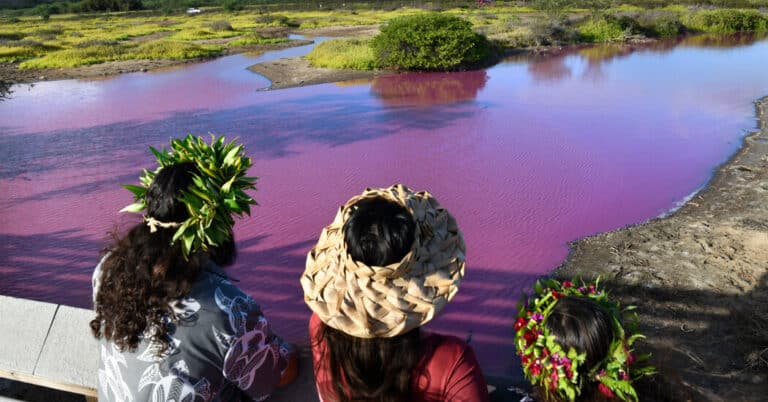A pond in Hawaii became a social media spectacle this week after turning bubble-gum pink. However, experts said the new hue was not just a photo opportunity but an indicator of environmental stress.
Staff members at the Kealia Pond National Wildlife Refuge on Maui have been monitoring the pink water for the last two weeks, according to the U.S. Fish and Wildlife Service, after initial fears that the color was a result of toxic algae.
Instead, tests have indicated source of the pink hue was likely halobacteria, a type of archaea, or single-celled organism that thrive in bodies of water with high levels of salt, the service said.
The salinity inside the Kealia Pond outlet area is currently greater than 70 parts per thousand, which is twice the salinity of seawater.
Paired with the dry conditions resulting from Maui’s drought, which is rated as “severe” in the majority of the county, the pond’s salinity created the perfect conditions for the halobacteria to thrive.
The University of Hawaii is conducting further tests to learn more about the archaea.
If the microorganism is a halobacteria, the water is not likely to pose a public health threat, said Dr. Shiladitya DasSarma, a professor in the department of microbiology and immunology at the University of Maryland School of Medicine.
The microorganisms would not be able to survive in the human body because the body doesn’t have enough salt for the halobacteria to survive, Dr. DasSarma said.
Still, officials have advised visitors to stay out of the water, to avoid consuming any fish from the pond and to ensure that pets don’t drink from it either.
The bright pink hue is still a cause for concern in the surrounding ecosystem.
The color indicates the water salinity levels are too high for most fish to survive or other animals to drink, he said.
“It’s basically a flashing red light that the ecology of this area is being gravely distressed,” Dr. DasSarma said.
Oftentimes, bodies of water have turned red before drying up, he said, though it’s unclear if that would be the case for Kealia Pond. Staff members at the wildlife refuge told The Associated Press that rainfall could reduce the salinity and potentially change the water’s color.
Such color changes are not unheard-of in the United States, Dr. DasSarma said.
Part of the Great Salt Lake in Utah, for instance, has been pink since the 1950s, according to the Great Salt Lake Collaborative, after a portion of it was split from the rest and developed a higher salinity.
Throughout the world, other pink or red lakes exist because of high salinity including in places like Spain, Senegal, the Crimean Peninsula, Azerbaijan and other elsewhere.
Usually, such color changes would occur in much drier places.
The latest episode in Hawaii, which usually has some humidity, speaks to more extreme weather events resulting from climate change, Dr. DasSarma said.
“This has been seen more commonly around the world, but one doesn’t think of Hawaii — it’s not an arid part of the world,” he said.


